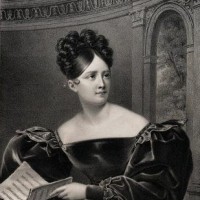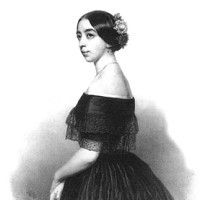The Garcia Sisters: Two Romantic Divas
|
Ellen MacDonald-Kramer [August 2013.] Recently I had the pleasure of visiting the Musée de la vie Romantique in Paris. Occupying the one-time home of painter Ary Scheffer, the little museum is exactly that: a shrine to some of the great personages of the Romantic age. Foremost among its subjects is the writer George Sand, known outside the world of the pen as Aurore Dupin – later, the Baroness Dudevant, and a lover of Franz Chopin. In one of the upstairs rooms I came across two of my favorite characters of nineteenth-century Europe in the form of two soft-textured portraits. One of the young women appeared vivacious and cunning, a hand webbed by the mass of dark hair falling over her shoulders in a pose almost suggestive of motion. I had previously seen her image in books, observed that tiny hint of a restless smile. The other portrait depicted a very different young woman, her hair in a tight knot, her lips very firm, and her arms folded elegantly in front of her. She possessed, in contrast to her painted companion, a demeanor suggestive of patience and even wisdom. These were the Garcia sisters, two of the nineteenth century’s greatest operatic singers, but known to posterity by their married names: Maria Malibran and Pauline Viardot. Separated by thirteen years and infinitely different natures, they were daughters of the noted tenor and voice teacher Manuel Garcia. Being a specialist in Rossini’s operas, Garcia was very much a proponent of the bel canto style of singing – that is to say, the Italian school of singing developed and pioneered in the previous century by composers such as Porpora and castrati like Farinelli, but which endured in the compositional style of Rossini and his contemporaries. Bel canto was centered around the fluidity of notes sung on the breath (legato), an evenness of bright and dark tones in the voice (chiaroscuro), and what was also known as florid singing (fioritura); in short, fast and highly embellished passages of music.
Histrionics certainly became central to the career of Garcia’s daughter Maria – or, La Malibran, as she became known. Born in 1808, Maria’s early years rendered her profession inevitable. Her father being the primo uomo he was, he coached his daughter with a barbarous determination. Legend has it that the Garcias’ neighbors learned to shrug off the frequent disruption of the girl’s cries, saying callously to one another, ‘It’s only Garcia, beating trills into his daughter.’ Needless to say, it worked. Maria equaled and even surpassed the fame of Giuditta Pasta, both her idol and her predecessor in a similar repertoire. She carried on the castrato-cultivated art of florid singing, and if her voice (variously called a soprano or mezzo-soprano) was brilliant in its range and agility, her acting bordered sometimes on the extreme. Maria was, in every sense, a star of the Romantic period. Both her professional and personal lives were inexhaustible. Warm and gregarious, she befriended others easily – and one might imagine, based on the trauma of her childhood, that there was something incredibly needy about her. She acquired her famous name from a husband almost thirty years her senior, whom she married either (it is uncertain) to escape her father, or at her father’s behest – perhaps both. If there was love in the marriage, it was short-lived; Maria left Eugène Malibran and eventually became mistress to Charles Auguste du Bériot, a Belgian violinist. Malibran reigned in opera before its greatest Romantic heroines – Violetta, Mimi, Madama Butterfly – had been conceived of, but she possessed many of their passionate characteristics. She was also, in the end, just as fragile. Her startling energy endured even after she fell off her horse, miscarried her child and suffered a head injury. Weeks after the riding accident, despite struggling with the pains of the injury, Maria insisted she was fit to sing in public. Perhaps it was because she had never rested in her life that nobody tried to stop her when she rose from her deathbed to perform at a concert. Her last singing engagement is the idealized finale of a true Romantic heroine. Legend tells us she sang more beautifully than she ever had before being assisted offstage where she promptly collapsed. We might also imagine the consumptive Violetta, of La Traviata, rising from her bed to deliver a last series of lovelorn farewells to her beloved Alfredo. Malibran’s life, at least superficially, was the stuff of opera. She was twenty-eight when she died in 1836.
Pauline Garcia lived much of her youth in her sister’s shadow. After all, she was only fifteen at the time of Malibran’s death. But like her sister, her operatic career began in her teens – an almost impossible notion today – and like her sister, she opted for an older husband. Louis Viardot was a practical choice: a successful writer and theater director who happily managed his wife’s career. It was a good, enduring marriage. Possessed of an expressive mezzo-soprano voice and a subtle, naturalistic approach to acting, Pauline was the inspiration of composers including Meyerbeer, Saint-Saëns, Massenet, Berlioz, and Gounod. Notably, Meyerbeer, in his opera Le prophète, wrote the role of Fidès for her. She was a member of Parisian intellectual circles, admired for her mind as well as her voice, and fluent in six languages. Pauline was loved by the writers Alfred de Musset and Ivan Turgenev, the latter of whom went so far as to move into the Viardots’ home. Pauline was a great friend of Franz Chopin and his mistress, the previously-mentioned George Sand. When a rift appeared in the Chopin-Sand relationship, she is said to have tried to reconcile them, to no avail. Sand’s admiration for her friend was so great that she based the title character of her 1843 novel, Consuelo, on Pauline. Consuelo is a young and homely Spanish singer who proves her purity and morality in the face of superficial temptations. Sand places her heroine as a student of Porpora, ‘the first teacher of singing in the universe’ and innovator of bel canto. Pauline, the inspiration, was paid a compliment of the highest order. Both the Garcia sisters were composers, a rare profession for women in their century, though Viardot’s works have better survived the test of time. Nor were Maria and Pauline the only children of the great tenor Manuel Garcia; they had an older brother, named after his father. Despite his status as only a second-rate baritone, the younger Manuel Garcia became a renowned teacher and vocal pedagogue and lived until the age of 101. Pauline, though she lived to eighty-eight and saw the advent of recording technology, never immortalised her voice on the gramophone (she was, by then, long past her prime). The voices of the Garcia sisters – of Malibran and Viardot – survive as legend only, and we may suspect their musical legacies to have been idealized by the aesthetic period in which they lived. How appropriate it is, then, that their portraits hang in the Musée de la vie Romantique: two distinct personalities, each one visually captivating. For the musical side, however, we’ll use our imaginations.
[More Ellen MacDonald-Kramer]
[Previous Article:
Used Bin Troll Tweets B.]
[Next Article:
Duodenal Etiquette, Scènes de Ballet]
|

